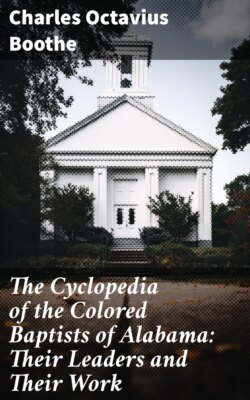Читать книгу The Cyclopedia of the Colored Baptists of Alabama: Their Leaders and Their Work - Charles Octavius Boothe - Страница 24
На сайте Литреса книга снята с продажи.
ORGANIZATION IN ALABAMA.
ОглавлениеTable of Contents
In 1864 there were four Colored Missionary Baptist Churches in Alabama, owning property worth about $10,000. Two of these were located in Mobile city—the Stone and the St. Louis Street Churches. Another was located in Selma, and is now known as the First Colored Baptist Church.
Rev. L. S. Steinback in the Act of Baptism.
Of course there was no association, no convention, no graded school of learning. The colored people of Mobile enjoyed superior advantages over those of other sections of the State and hence many of them had made fair attainments in letters. But in all the State there was but one Baptist preacher, to the writer’s knowledge, in April, 1865, who could, with any degree of honesty, claim to be an educated Baptist negro preacher. This was one Rev. Moses B. Avery. I think he is now in Mississippi. Anyhow I know that soon after the close of the war he joined the Methodist brethren and left the State. It will be seen, therefore, that he was no help to the Colored Baptists of Alabama.
The change which the war had wrought as to the civil status of the black man, changing him from slave to freedman, affected his church standing, so that ex-master and ex-slave did not quite fit each other in the old “meeting house,” as they had done in days of yore. There was restlessness on one side, and suspicion on the other. The black man wanted to go out and set up housekeeping for himself, while the white man in most cases feared and hesitated to lay on the hands of ordination. We did not know each other. The “negro preacher” on one side of the river had but little opportunity to know his brother on the other side. Truly our beginning was dark and chaotic.
It is said that necessity is the mother of invention. In all ages of the world, and with all peoples, want—a sense of need—has gone before human creations. The black man of the South was like, in this, the balance of human kind. When set at liberty, he was for some time lost in looking upon the wonderful changes that had passed over him. But when he came to himself he began slowly to realize his needs. He began, for example, to feel the need of church and of school, and out of this feeling of want on these lines there arose thought, discussion, plan, action. Those who were of like faith and gospel practice began to meet for prayer and for conference, and at last to unite in church covenant, forming churches. Then churches, under the leadership of progressive men, were joined in associational compacts. They met first only to sing and pray, and listen to talks from white brethren. Want increased; burdens increased; the horizon of duty and possibility widened. Under a sense of duty and repeated exercise, mind and heart developed into greater strength and into greater capacity for thought, plan, speech, and execution. Kindred spirits sought each other’s fellowship and counsel, and talked about the work which might be done. Soon it was felt by some that a general State Convention was both necessary and possible. The desire, plan and call for such an organization ripened among the brethren at and around the Capital City. Perhaps Montgomery was foremost, for the reason that here was the legislature, and here the colored people saw most of deliberative bodies, and heard most about their needs and opportunities.
Mrs. Dinah Smith Jordan, Birmingham, Ala.
